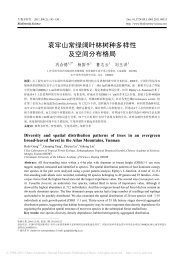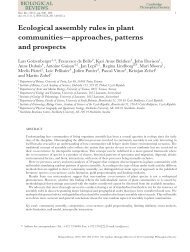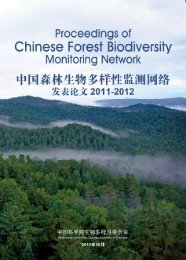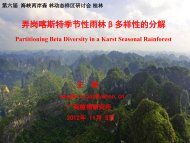the maintenance of species-richness in plant communities
the maintenance of species-richness in plant communities
the maintenance of species-richness in plant communities
You also want an ePaper? Increase the reach of your titles
YUMPU automatically turns print PDFs into web optimized ePapers that Google loves.
Ma<strong>in</strong>tenance <strong>of</strong> <strong>species</strong>-<strong>richness</strong> <strong>in</strong> <strong>plant</strong> <strong>communities</strong> 125<br />
<strong>of</strong> viable seed and to <strong>the</strong> evolution <strong>of</strong> <strong>the</strong> variety <strong>of</strong> flower<strong>in</strong>g and fruit<strong>in</strong>g 'strategies'<br />
(not least <strong>the</strong> variation <strong>in</strong> phenology), but attention is concentrated here on <strong>the</strong> fact<br />
that <strong>in</strong> any one <strong>species</strong>-rich community <strong>the</strong> proportions <strong>of</strong> viable seeds <strong>of</strong> different<br />
<strong>species</strong> fall<strong>in</strong>g on any one area are certa<strong>in</strong> to vary appreciably from year to year.<br />
(b) Dispersal<br />
First, we are concerned with dispersal <strong>in</strong> space. In every <strong>species</strong>-rich community<br />
that has been studied a great variety <strong>of</strong> dispersal mechanisms has been found (van der<br />
Pijl, 1971). There can be little doubt that seeds <strong>of</strong> some <strong>species</strong> are, <strong>in</strong> general,<br />
dispersed fur<strong>the</strong>r afield than those <strong>of</strong> o<strong>the</strong>rs and it has long been appreciated that wide<br />
dispersal is important <strong>in</strong> <strong>species</strong> less fit <strong>in</strong> a competitive struggle between vegetative<br />
<strong>plant</strong>s (Skellam, 1951). In addition <strong>the</strong> relative effectiveness <strong>of</strong> different types <strong>of</strong><br />
dispersal <strong>in</strong> space will vary from year to year <strong>in</strong> response to variations <strong>in</strong> w<strong>in</strong>d speed,<br />
w<strong>in</strong>d direction, abundance <strong>of</strong> particular animal vectors, <strong>in</strong>cidence <strong>of</strong> flood<strong>in</strong>g, etc.<br />
The size <strong>of</strong> an <strong>in</strong>dividual gap <strong>in</strong> <strong>the</strong> community can also be important, e.g. <strong>in</strong> a large<br />
forest-clear<strong>in</strong>g few seeds <strong>of</strong> a heavy-fruited tree like Fagus reach <strong>the</strong> centre <strong>of</strong> <strong>the</strong> gap,<br />
but large numbers <strong>of</strong> light seeds such as those <strong>of</strong> Bet& may land <strong>the</strong>re; so Bet& is<br />
helped to persist <strong>in</strong> a forest dom<strong>in</strong>ated by Fagus (Watt, 1934).<br />
Secondly, we are concerned with dispersal <strong>in</strong> time. It is well established that <strong>the</strong> seeds<br />
<strong>of</strong> <strong>the</strong> various <strong>species</strong> <strong>in</strong> particular <strong>communities</strong> vary <strong>in</strong> <strong>the</strong> length <strong>of</strong> time for which<br />
<strong>the</strong>y rema<strong>in</strong> viable and that this variability is reflected <strong>in</strong> <strong>the</strong> seed bank <strong>of</strong> <strong>the</strong> soil.<br />
Information on which <strong>species</strong> <strong>in</strong> particular <strong>communities</strong> are most abundant <strong>in</strong> <strong>the</strong> seed<br />
bank is available for temperate grasslands (Chipp<strong>in</strong>dale & Milton, 1934; Champness<br />
& Morris, 1948; Major & Pyott, 1966), and for temperate and tropical forests (Guyot,<br />
1960; Guevara & G6mez-Pompa, 1972; Marks, 1974). It is probably extremely<br />
important for many subsidiary <strong>species</strong> that <strong>the</strong>y can regenerate from seed that has been<br />
<strong>in</strong> <strong>the</strong> soil for decades, whenever and wherever a gap arises <strong>in</strong> <strong>the</strong> community.<br />
Examples are <strong>species</strong> <strong>of</strong> Agrostis, H o h and Poa <strong>in</strong> grasslands <strong>in</strong> western Europe able<br />
to benefit from gaps made by animals, and <strong>species</strong> <strong>of</strong> Hypen'cum, Juncus and Verbascum<br />
<strong>in</strong> forests <strong>in</strong> <strong>the</strong> same area able to benefit from gaps made by tree-falls.<br />
It is certa<strong>in</strong> that seeds <strong>of</strong> different <strong>species</strong> vary <strong>in</strong>herently <strong>in</strong> longevity but differences<br />
<strong>in</strong> survival under natural conditions may be more closely related to palatability,<br />
digestibility and <strong>the</strong> <strong>in</strong>cidence <strong>of</strong> predators (animals and microbes) than to <strong>in</strong>herent<br />
differences <strong>in</strong> longevity. Seeds certa<strong>in</strong>ly differ <strong>in</strong> palatability (Janzen, 1969) and <strong>the</strong><br />
fact that <strong>the</strong> loss to predators is tremendous has been documented not only for forest<br />
trees with relatively large seeds (Watt, 1919, 1923; Curtis, 1959; Janzen, 1970;<br />
Medway, 1972) but also for herbs with quite small seeds (Tevis, 1958; Bohart &<br />
Koeber, 1972; Sarukhhn, 1974). However, <strong>the</strong>re are still very few data available on <strong>the</strong><br />
absolute losses to microbes as opposed to animals (Sarukhhn, 1974).<br />
Variability <strong>in</strong> predation <strong>in</strong> time and space is bound to contribute to <strong>the</strong> variation <strong>in</strong><br />
<strong>the</strong> numbers <strong>of</strong> viable seeds present at <strong>the</strong> time <strong>of</strong> formation <strong>of</strong> a particular gap.<br />
Janzen (1970) has placed great stress on losses to animals at this stage as critical to <strong>the</strong><br />
<strong>ma<strong>in</strong>tenance</strong> <strong>of</strong> diversity <strong>in</strong> tropical ra<strong>in</strong>-forests, argu<strong>in</strong>g that more or less host-specific<br />
predators, accumulat<strong>in</strong>g on <strong>the</strong> parent tree, can destroy most seeds fall<strong>in</strong>g under it,
















